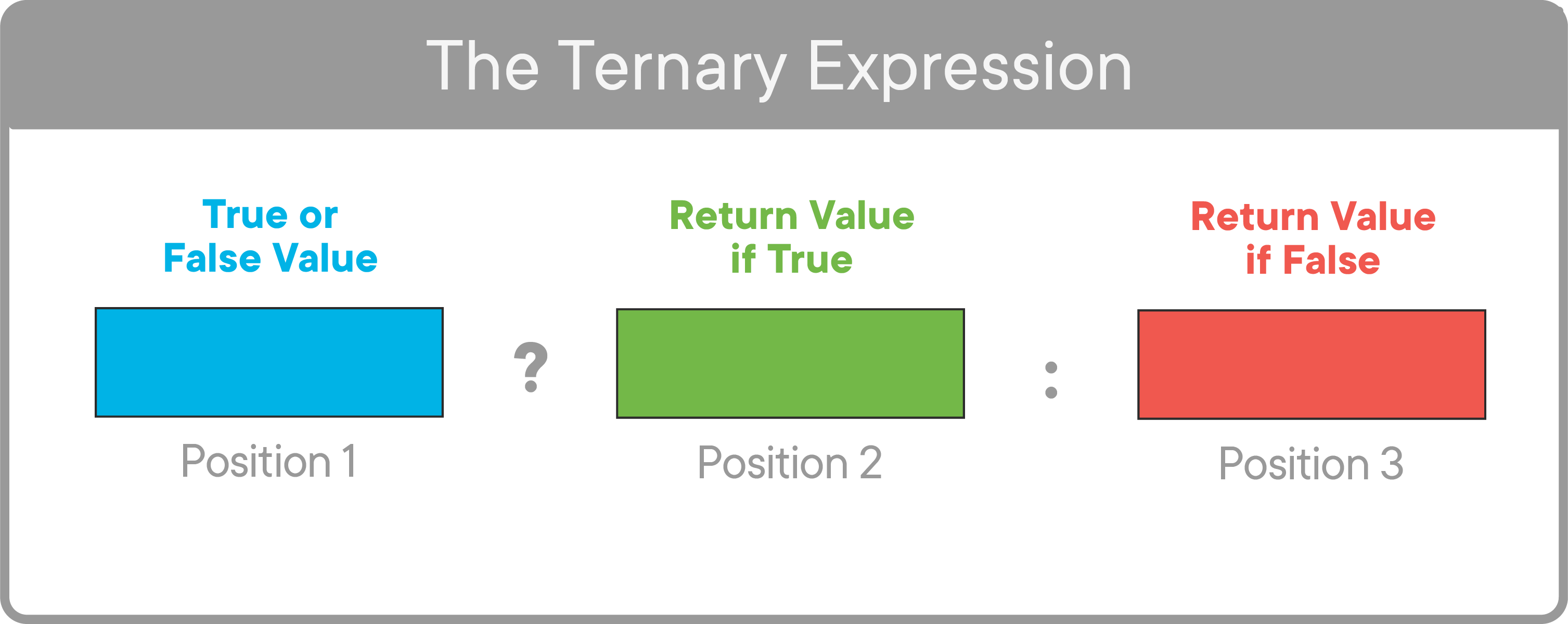The Ternary Expression and Logic
Learning Goals
- Identify the Ternary Expression
Introduction
As conversationalists with computers, we've come so far so fast! We're able to construct complex expressions and store their evaluations in variables. We can also retrieve those stored values from the variables through the variable lookup expression. We can even assign the results of complex arithmetic expressions into those variables.
But our expressions have always followed a single track: evaluate this one single expression, or line of thought. It's like a world of absolute certainty in every statement: "My outfit today: rain boots" or "My outfit today: sun hat." Real-life sometimes needs to vary based on a test of some sort. IF it's raining: rain boots OTHERWISE: sun hat." This means that complexity is entering our expressions, but we need that complexity so that we can document our problem-solving strategies in code.
We will now learn how to write an expression that expresses "conditional thinking" or "if-then" logic. It's called The ternary expression. It's an expression that can return one of two values, based on the truth-status of its first expression.
Identify the Ternary Expression
The ternary expression looks like this:
Or, in Ruby:
boolean_conditional_value ? "thing_to_return_if_true" : "thing_to_return_if_false"If the expression in the first position evaluates to anything except nil or
false, then the return value of the ternary expression is whatever is in
Position 2; here, "thing_to_return_if_true". If the expression in Position 1
returns nil or false, whatever is in Position 3 is returned; here,
"thing_to_return_if_false".
NOTE: Programmers don't use the terms "Position 1" or "Position 2" in daily use (although they might be smart to adopt a standard!). We're using those only to help communicate about the parts of a ternary expression
Something that a lot of new programmers miss is that this "something ?
something : something" expression is an expression it has a return
value and can be assigned to a variable!
Here's an example to try out in IRB:
likely_to_rain = true
garment = likely_to_rain ? "rain boots" : "sun hat"
garment #=> "rain boots"As you see above, the return value of the ternary expression is assigned to
garment. You can use the variable lookup expression to verify that the
value of garment is "rain boots".
In IRB, try changing the variable likely_to_rain with the assignment
expression from true to false. Then run the ternary expression again. The
value of garment should become sun hat.
We now have the ability to express conditional logic in our expressions. You should try writing several ternary expressions yourself in IRB to make sure you've gotten the hang of things.
LEARNING TIP: Developers learn their craft by making slight experiments to given code: be sure you're adopting that habit now.
Moving Beyond Boolean
Keep in mind that the first term in a ternary statement can also be an
expression that returns a Boolean value of true or false. It does not
have to be the exact true or false value. Instead, in the first slot can
be an expression that returns a truth value that is calculated by an
expression. We'll provide two simple examples here and go into a lot more
detail in the next lesson.
From arithmetic, recall this statement: 2 > 1 which expresses is the quantity
2 "greater than" 1? Try putting this expression into IRB: does IRB
confirm that it evaluates to true? It should! That's what we mean by
calculated truth value. Based on the evaluation of an expression, Ruby
returned a true or false value that could be used in the ternary
expression.
Try updating your original IRB code
garment = 2 > 1 ? "rain boots" : "sun hat"
garment #=> "rain boots"This logic makes garment "rain boots" again. Try swapping > for <, is
that what you expected? That's a second operator for calculating truth: instead
of greater-than (>), we used less-than (<). These operators are known as
comparison operators. Comparison operators return true or false. We'll
meet the whole family of them in the next lesson.
The important thing to take away is that you can always swap a literal true
or false for an expression that returns true or false.
Even more amazing, we can swap out the simple Strings we've used in Positions
2 and 3 of our first ternary with expressions as well.
top = 2
bottom = 1
problem_count = 99
lucky_number = (top > bottom) ? ( 3 + 1 ) : ( problem_count / 3 )
lucky_number #=> ??? (Test it out yourself!)What's the value of lucky_number? Step through the expressions to make you
understand what happens step by step.
STYLE TIP: To make reading the expressions in the ternary statement's positions clear, we wrap them in
(). It's done for readability and to prevent accidental order of operations bugs.
Conclusion
The ternary expression is where our expression-writing starts to make a leap upward in complexity. But if we bear in mind that it's always an expression that, itself, contains three "inner" expressions, we'll be able to keep moving forward comfortably.
NOTE: Those familiar with programming languages might be wondering, why not use
if/elsestatements. We'll work our way up to them, but for now realize that expressions can provide conditional power (and in one line!).

